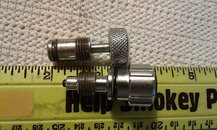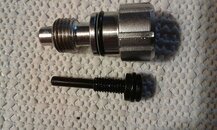I enjoy picking up used regulators (mostly Scubapro), a hobby allowing me to play with and compare various regulators as well as picking up gear at a sweet price. The fun began years ago when I became interested in regulator discussion here on Scubaboard, and continues with the continued influence and information shared by many here. Thank you!
I will be working thru a few regulators over the next couple months, and hope to contribute a small bit to this board and the DIY cause. A freebie SP G260 was this evenings project, a recent score that looks 95% new cosmetically but was breathing poorly.
Disassembly went very smooth due to the newness of the regulator and lack of saltwater use. A nice change from some older second stages, where certain parts (eg the orifice) can be a bit stuck from salt residue, corrosion, and age.
Reassembled after cleaning, replacing poppet seat, and re lubing the orings after inspection. The fine tuning screw adjustment added to the adjustment knob is very simple, requiring only a hex wrench and adding almost no time to the process. Overall, I would rate the G260 rebuild work as being the same as a G250.
The end result is a stable cracking pressure of .75, very pleased with the regulator. I have been a bit turned off by the relative complexity dealing with the fine tuning screw of S600/G500 in the past, but have to say I like the version on the G260, fine tuning was so simple and seemed to make the final adjustment a bit easier. Time will tell on overall satisfaction, it should get a lake test run sometime next week.
I will be working thru a few regulators over the next couple months, and hope to contribute a small bit to this board and the DIY cause. A freebie SP G260 was this evenings project, a recent score that looks 95% new cosmetically but was breathing poorly.
Disassembly went very smooth due to the newness of the regulator and lack of saltwater use. A nice change from some older second stages, where certain parts (eg the orifice) can be a bit stuck from salt residue, corrosion, and age.
Reassembled after cleaning, replacing poppet seat, and re lubing the orings after inspection. The fine tuning screw adjustment added to the adjustment knob is very simple, requiring only a hex wrench and adding almost no time to the process. Overall, I would rate the G260 rebuild work as being the same as a G250.
The end result is a stable cracking pressure of .75, very pleased with the regulator. I have been a bit turned off by the relative complexity dealing with the fine tuning screw of S600/G500 in the past, but have to say I like the version on the G260, fine tuning was so simple and seemed to make the final adjustment a bit easier. Time will tell on overall satisfaction, it should get a lake test run sometime next week.






